Kap-Dwa - a two-headed giant
07 Apr 2021Kap-Dwa is allegedly a mummified body of a 12-foot [3.7 m] tall two-headed giant from Patagonia, making him potentially the only material proof of Patagonian giants we have.
Side-note: Right from the start, we should note that although the Patagonian giants are well established in the historical record, there are no mentions of the two-headed variety, apart from those discussed below.
See also: Patagonian Giants

The usual narrative, on which the majority of articles on Kap-Dwa are based, comes from a story run by British magazine Fortean Times, specializing in anomalous phenomena and mysteries, from 1998 to 2000.
The Two-headed Patagonian Giant”, said to have been over 12ft (3.7m) tall, was a famous fairground attraction allegedly brought to England in the 19th century. The story was that he had been captured by Spanish sailors in 1673 and bound to the mainmast. He broke loose and killed four of his captors, before being killed himself by a boarding pike plunged into his heart [FT112:15] 1
In the early 1900s, the stuffed giant was purchased by a Mr Bartram who toured the country on the Edwardian horror circuit, ending up in Weston-super-Mare in Somerset, where the curiosity passed through several hands and was exhibited at various locations. […] It was sold to a showman called “Lord” Thomas Howard in 1959, after which it left Weston.1
Some websites also mention that there are other versions of the story, or conflate them together, but we will get to each of them later. So, let’s see what we can find in the depths of the internet.
Origins
The earliest record we could dig up mentions the two-headed Patagonian giant only circumstantially in an 1889 Pittsburgh Dispatch column, which used him for a proposal of a ‘psychological puzzle’ about the workings of the giant’s mind. The giant is not named. More importantly, though, it provides us with the historically first version of the story:
He was captured 200 miles from the coast of Patagonia. Both of his heads were lassoed at one and the same time by two Western cowboys. […] The giant was subdued only when 160 shots from a Gatling gun had been poured into his body. This remarkable product of animal kingdom has been examined by the wise men of the Smithsonian Institute and pronounced to be the Simon-pure, 18-carat article.2
Trace continues in an 1891 The Philadephia Inquirer column about C.A. Bradenburgh’s dime museum in Philadelphia. His alleged origins remain Patagonian and he is reported to be 11 feet tall.3
Side-note: Among other requisites “the Turtle Boy, who is half boy and half turtle” is also advertised.
 The earliest confirmed location of two-headed Patagonian giant - C.A. Bradenburgh's Arch Museum on 9th and Arch Streets, Philadelphia, 1890s.
The earliest confirmed location of two-headed Patagonian giant - C.A. Bradenburgh's Arch Museum on 9th and Arch Streets, Philadelphia, 1890s.
According to an 1893 newspaper ad, the giant’s next stop was in M.C. Anderson’s Wonderland Musee & Theatre in Wilkes-Barre, Pennsylvania.4
Another newspaper reference leads us out of Pennsylvania for the first time. The giant was exhibited in Clark Street Museum, Chicago in 1899. However, this time the advert says that he is of Maori origin [New Zealand]. 5
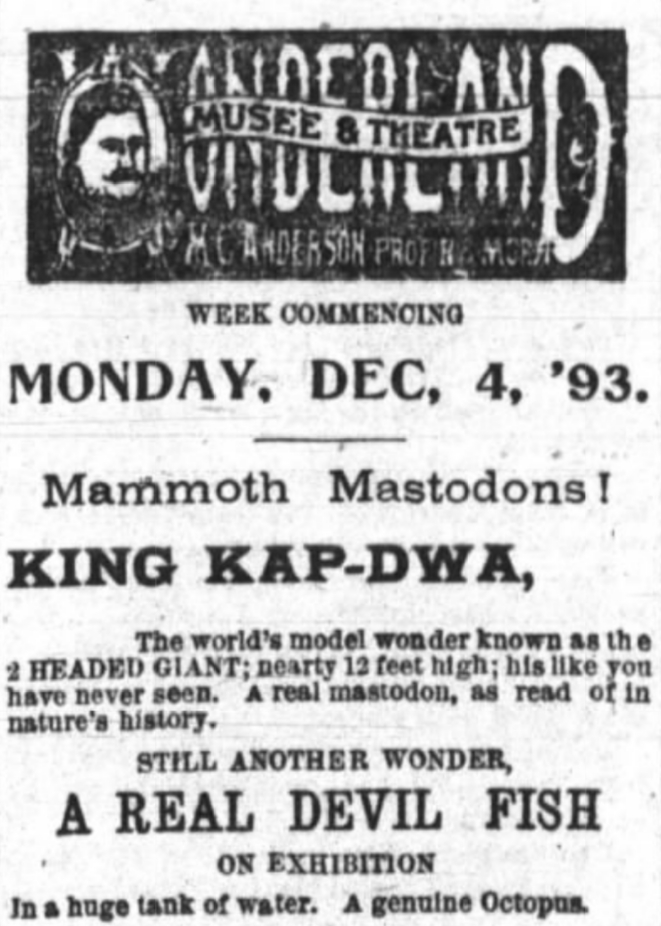 |
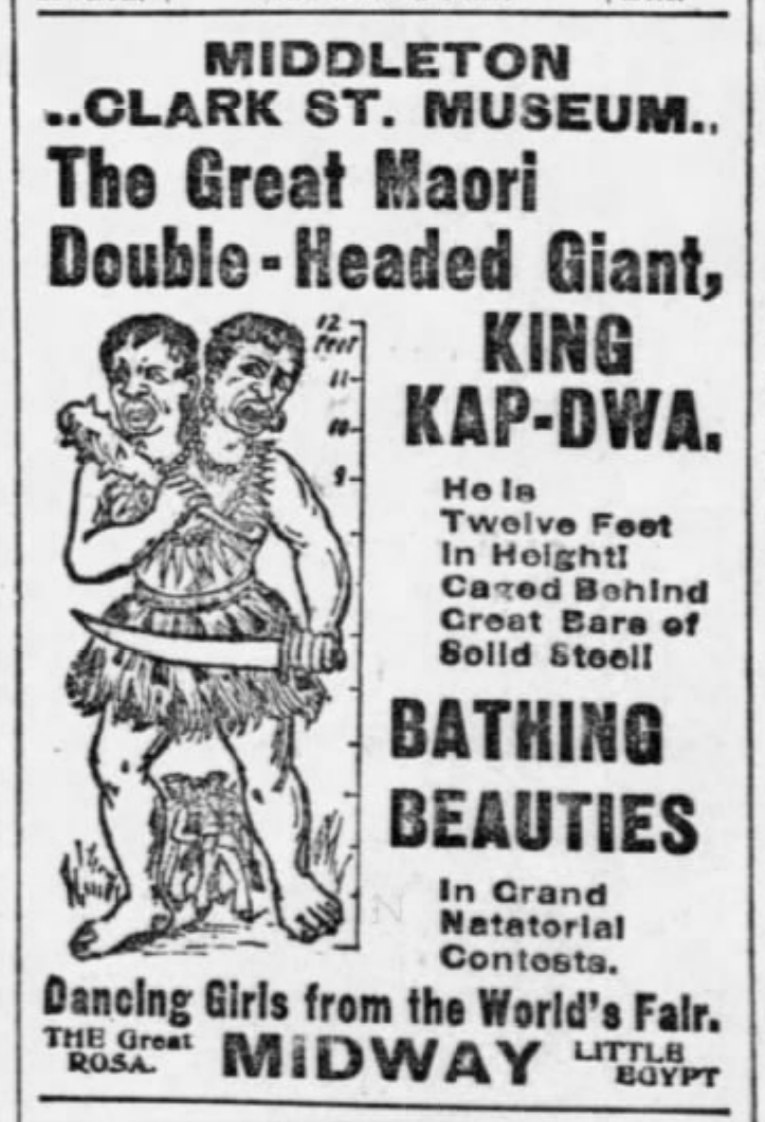 |
| The Wilkes-Barre Record, 1893 | The Chicago Tribune, 1898 |
A trip to England
After that, it seems to had made its way into England. It was actually listed several times for sale in “want ads” in English print between 1989 and 1900.6 One of the ads lists Bertram among its keywords, lending some credibility to FA’s story (although they spell it Bartram).
Eventually, just as the Fortean Times say, it wound up in the Grand Pier in Weston-super-mare, England, which we can confirm with 1931 book by John Fothergill, an English innkeeper, and entrepreneur, who visited the pier and was fascinated by Kap-Dwa. He even set out to verify its authenticity by appointing physicist Guy Brown, an unnamed radiologist from Weston-super-mare hospital, and a local doctor, who allegedly inspected it and found “no perceptual evidence of its being a fake.”7 The book doesn’t say whether this conclusion was based just on observation, or whether some more rigorous methods were used.
Much later, the giant was to be seen at Nottingham Goose Fair on 4th October 1959, as shown in this video around 08:10 mark8. If we’re to believe Fortean Times, it was owned by Thomas Howard during this time and it remained in England until at least 1971 (based on a photograph of the exhibit at Newcastle).
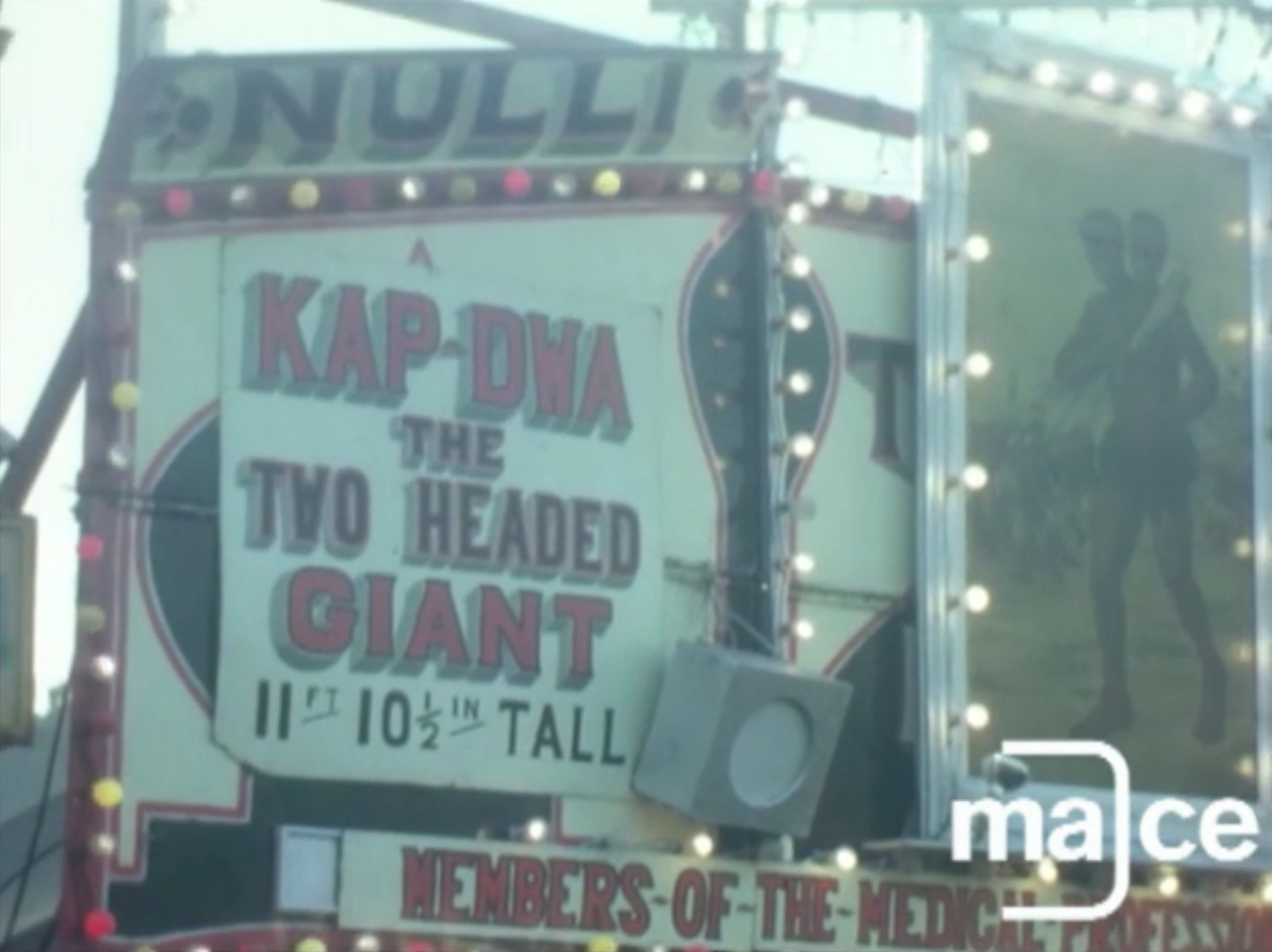 |
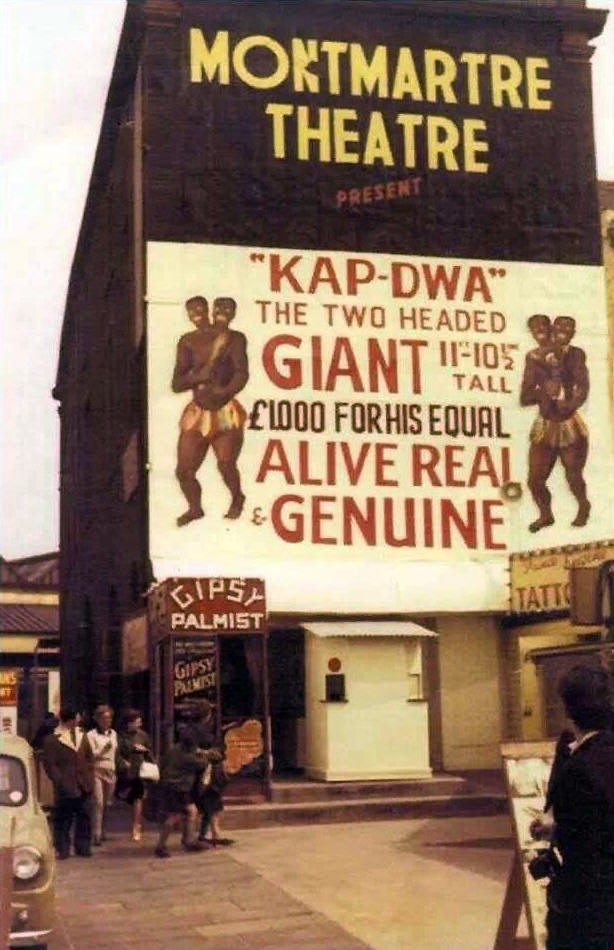 |
| 1959, Goose Fair, Nottingham, England | 1971?, England |
Back in the USA
The next mention is in an American newspaper from 1976. This time, Kap-Dwa was exhibited at various places in New Jersey and was said to be 2,000 years old.9 10 An article from a different newspaper from the same year repeats the 2,000 number and identifies the owner as a British woman named Chris Howard.11
This once again seems to confirm the research conducted by Fortean Times which reports that “Howard sold or transferred Kap Dwa to his brother Scott in New Jersey.”
It’s not clear where FA’s story about Spanish captors came from, but the Howard family apparently still favored the 2,000 years old narrative as late as 1977, indicating that the story emerged later. Fortean Times unfortunately, doesn’t provide any verifiable sources for their claims.
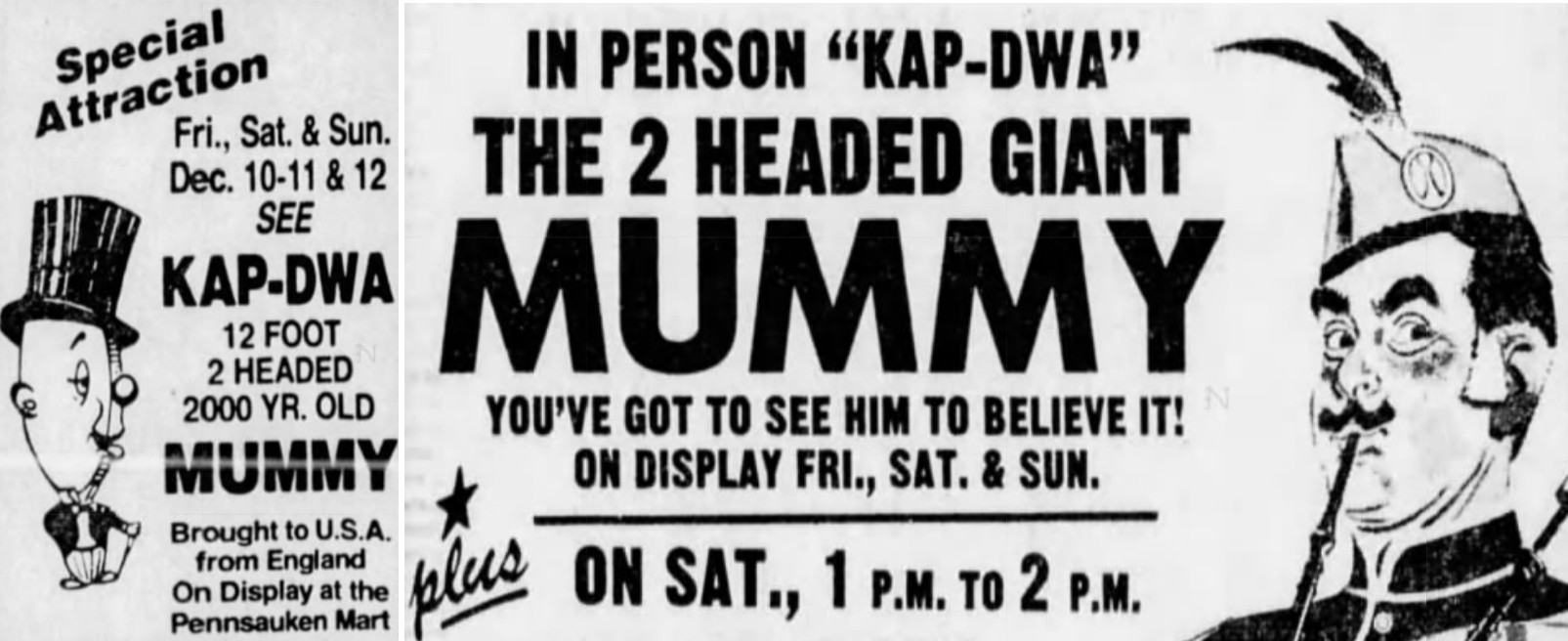 Ads for Pennsauken mart from 1976—77.
Ads for Pennsauken mart from 1976—77.
The exhibit now rests in a small curiosities and oddities shop called Bob’s Side Show in Baltimore, owned by Robert Gerber. He doesn’t mention how he obtained it. According to his website:
The mummy was brought to England in the early 1800’s from Paraguay by Captain George Bickle who sailed out of Plymouth, England on the clipper ship Olive Branch. It is said that the great P.T. Barnum tried in vain to buy Kap-Dwa on one of his trips to England. It was not until the mid 1950’s that Kap-Dwa left the Blackpool Museum to go on tour in the United States.12
This account is evidently not very in line with the newspaper evidence presented earlier. Also, although various ships named HMS Olive Branch existed, there are no records of any captain George Bickle. Berger was also quoted in a 1996 newspaper article saying that:
“We’ve had students from Hopkins [University], droves of them, and they all say he’s real.13
However, there doesn’t seem to be any scientific report from Hopkins or any other universities or museums about this artifact. This article also quotes a collector and sideshow historian Warren Raymond that “Nelson’s Supply House in South Boston cranked out Patagonian giants, charging $60 apiece.” confirming the advert mentioned earlier.
Although the Fortean Times published their aforementioned article two years after this news article was published, FA didn’t even acknowledge Gerber until four issues later. So it seems that the story of Spanish sailors emerged after 1977 but before 1996. By the way, they speculated that the American one could be an imitation.1
To be fair, we do know that some replicas were made. A 1939 article in The San Francisco Examiner reprints an advertisement for a mummy they call King Capuwar, 8 feet tall. “Made so Legs come off at the waist so as to ship in a box”14.
On the other hand, the photo shown in the article bears absolutely no resemblance to Berger’s mummy and the full-body which FA claims to be from the 60s matches Gerber’s mummy perfectly. Moreover, there are no mentions of Kap-Dwa in English print after the 1970s and American newspaper reports starting in the 1970s suggest that it might be the same artifact.
At the end of their article, the Fortean Times concludes with a statement that “showman Billy Hill had bought the giant from Howard in Blackpool” and that “he was last exhibited in Newcastle in 1999”.
 Mummy in Bob's Side Show, Baltimore
Mummy in Bob's Side Show, Baltimore
Summary
-
Although the usual story correctly says that it was brought from England, the fact the mummy has its origins in American sideshows and dime museums is conveniently omitted.
-
Fortean Times story about Spanish sailors or Berger’s story of captain George Bickle are not supported by any other sources.
-
The mentions of England apparently emerged only after it returned to the USA.
-
After the body left the USA, at least two other giants, most likely imitations, continued to be exhibited in the United States, namely King Mac-A-Dula and King Capuwar.15 Interestingly though, the name Capuwar appears as early as 1892 and actually predates the name Kap-Dwa in print.16
-
Although it had been put forward that the body was examined by various scientists, there is no published scientific analysis of Kap-Dwa, despite the fact that it is known where he is currently located.
-
Given the context of the first appearance of the artifact, it is safe to assume that it is just an example of a gaff taxidermy produced for entertainment and presentation purposes, similar to e.g. Fiji mermaids created from monkey and fish remains sewn together.
Sources
Unfortunately, the newspapers.com sources are pay-walled, but you can get a free 7-day trial.
-
The two-headed giant on Fortean Times website (archived) (archive.org) ↩ ↩2 ↩3
-
Pittsburgh Dispatch, Pittsburgh, Pennsylvania, 03 Nov 1889, p. 7 (newspapers.com) ↩
-
The Philadelphia Inquirer, Philadelphia, Pennsylvania, 27 Nov 1891, p. 7 (newspapers.com) ↩
-
The Wilkes-Barre Record, Wilkes-Barre, Pennsylvania, 06 Dec 1893, p. 7 (newspapers.com) ↩
-
The Inter Ocean, Chicago, Illionis, 08 May 1898, p. 17, The Chicago Tribune, Chicago, Illinois, 08 May 1898, p. 42 (newspapers.com) ↩
-
The Era, London, England, 24 Dec 1898, p. 25, 18 Mar 1899, p. 26, 12 May 1900, p. 28, 06 Oct 1900, p. 26, 24 Nov 1900, p. 25, 22 Dec 1900, p. 26 (newspapers.com) ↩
-
Fothergill, John. An innkeeper’s diary, 1931, p. 66—68 (archive.org) ↩
-
Nottingham Goose Fair October 1959, The Media Archive for Central England (MACE) (macearchive.org) ↩
-
Asbury Park Press, Asbury Park, New Jersey, 26 Jun 1977, p. 4 (newspapers.com) ↩
-
The Philadephia Inquirer, Philadelphia, Pennsylvania, 27 Oct 1977, p. 6, Courier-Post, Camden, New Jersey, 06 Dec 1976, p. 14 (newspapers.com) ↩
-
The Courier-News, Bridgewater, New Jersey, 05 Sep 1978 (newspapers.com) ↩
-
Bob’s Side Show website (archived) (archive.org) ↩
-
The Baltimore Sun, 26 Dec 1996, p. 1D & 8D. newspapers.com) ↩
-
The San Francisco Examiner, San Francisco, California, 03 Aug 1939, p. 56 (newspapers.com) ↩
-
Rutland Daily Herald, Rutland, Vermont, 23 Sep 1909, p. 5, Courier-Post, Camden, New Jersey, 13 Aug 1915, p. 15 (newspapers.com) ↩
-
The Boston Globe, Boston, Massachusetts, 13 Mar 1892, p. 10 (newspapers.com) ↩